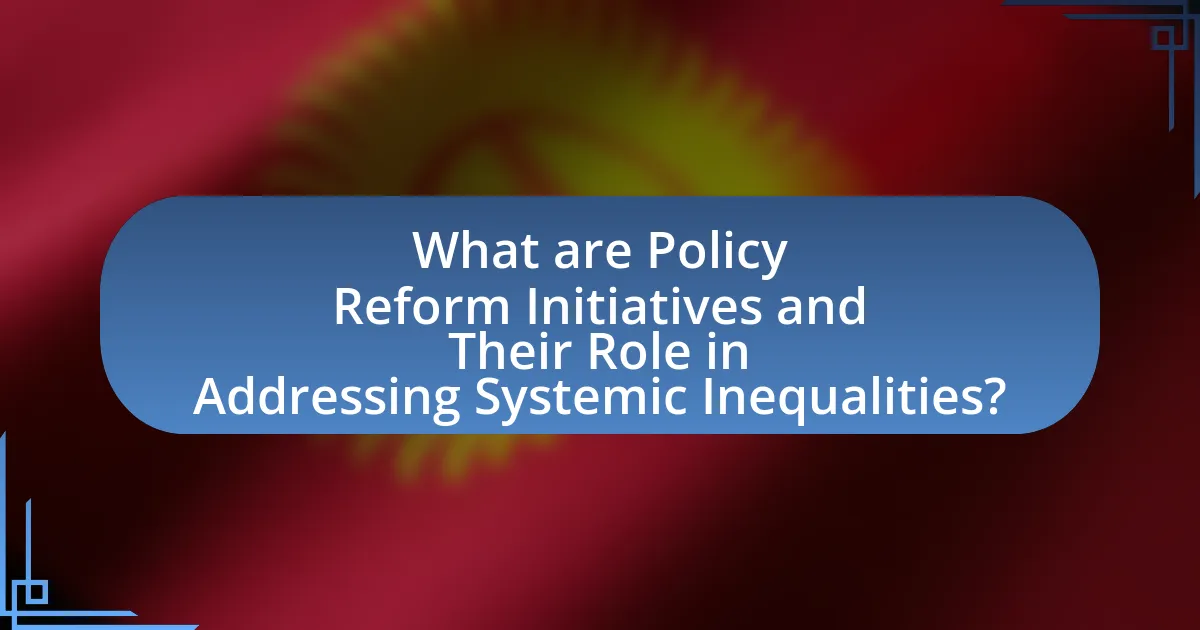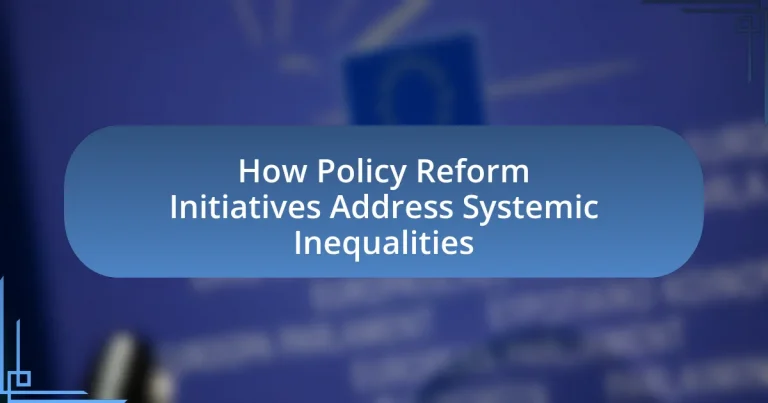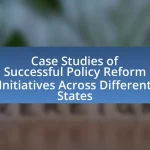Policy reform initiatives are structured efforts aimed at changing laws and regulations to promote social justice and equity, particularly in addressing systemic inequalities that affect marginalized communities. The article explores how these initiatives identify and dismantle barriers through data analysis, stakeholder engagement, and policy evaluation, employing both quantitative and qualitative methodologies. It highlights the historical context necessitating these reforms, the impact of systemic inequalities on various communities, and the strategies employed by stakeholders, including government agencies and non-profit organizations. Additionally, the article discusses the challenges faced in implementing reforms, the metrics used to evaluate their effectiveness, and best practices for enhancing their impact.

What are Policy Reform Initiatives and Their Role in Addressing Systemic Inequalities?
Policy reform initiatives are structured efforts aimed at changing laws, regulations, or policies to promote social justice and equity. These initiatives play a crucial role in addressing systemic inequalities by identifying and dismantling barriers that disproportionately affect marginalized communities. For example, reforms in housing policy can reduce discrimination and increase access to affordable housing for low-income families, thereby improving their socioeconomic status. Historical evidence shows that initiatives like the Civil Rights Act of 1964 significantly reduced racial discrimination in various sectors, illustrating the effectiveness of policy reforms in fostering equality.
How do Policy Reform Initiatives identify systemic inequalities?
Policy reform initiatives identify systemic inequalities through data analysis, stakeholder engagement, and policy evaluation. These initiatives utilize quantitative data, such as demographic statistics and socioeconomic indicators, to highlight disparities in access to resources and opportunities. For example, the U.S. Census Bureau provides data that reveals income gaps and educational attainment differences among various racial and ethnic groups, which can inform targeted reforms. Additionally, engaging with affected communities allows policymakers to gather qualitative insights into lived experiences of inequality, ensuring that reforms address real-world issues. Evaluating existing policies against equity benchmarks further helps to uncover systemic barriers, as seen in studies conducted by organizations like the Urban Institute, which assess the impact of policies on marginalized populations.
What methodologies are used to assess systemic inequalities?
Quantitative and qualitative methodologies are used to assess systemic inequalities. Quantitative methods include statistical analysis, surveys, and demographic data evaluation, which provide measurable insights into disparities across various social, economic, and political dimensions. For example, the U.S. Census Bureau collects data that reveals income disparities among different racial and ethnic groups, highlighting systemic inequalities. Qualitative methods involve interviews, focus groups, and case studies that explore personal experiences and perceptions of inequality, offering deeper contextual understanding. Research by the Pew Research Center illustrates how qualitative insights can complement quantitative data, revealing the lived experiences behind the statistics. Together, these methodologies provide a comprehensive framework for understanding and addressing systemic inequalities.
How do data collection and analysis contribute to understanding these inequalities?
Data collection and analysis are essential for understanding systemic inequalities as they provide empirical evidence that highlights disparities across various demographics. By systematically gathering data on income, education, health, and access to resources, researchers can identify patterns and trends that reveal the extent and nature of inequalities. For instance, the U.S. Census Bureau’s data shows that racial minorities often experience higher poverty rates compared to their white counterparts, illustrating economic disparities. Furthermore, analysis of this data allows policymakers to pinpoint specific areas requiring intervention, such as education funding or healthcare access, thereby informing targeted policy reforms aimed at reducing these inequalities.
Why are Policy Reform Initiatives necessary for addressing systemic inequalities?
Policy reform initiatives are necessary for addressing systemic inequalities because they create structural changes that promote equity and justice. These initiatives target the root causes of disparities, such as discriminatory laws and practices, by implementing new policies that ensure equal access to resources and opportunities. For example, the Civil Rights Act of 1964 in the United States was a policy reform that aimed to eliminate racial discrimination in various sectors, leading to significant improvements in social and economic conditions for marginalized groups. Such reforms are essential for dismantling entrenched systems of inequality and fostering a more inclusive society.
What historical context has led to the need for these initiatives?
The historical context leading to the need for policy reform initiatives addressing systemic inequalities includes the legacy of colonialism, slavery, and segregation, which have entrenched disparities in wealth, education, and access to resources. For instance, the Civil Rights Movement in the United States during the 1960s highlighted the systemic discrimination faced by African Americans, prompting legislative changes such as the Civil Rights Act of 1964 and the Voting Rights Act of 1965. These events underscored the necessity for ongoing reforms to dismantle institutional barriers and promote equity, as evidenced by persistent socioeconomic gaps that continue to affect marginalized communities today.
How do systemic inequalities impact different communities?
Systemic inequalities impact different communities by perpetuating disparities in access to resources, opportunities, and rights. For instance, marginalized groups often face barriers in education, healthcare, and employment due to historical discrimination and biased policies. According to the U.S. Census Bureau, Black and Hispanic households earn significantly less than their white counterparts, with median incomes of $45,870 and $51,450 respectively, compared to $74,580 for white households. This income gap leads to reduced access to quality education and healthcare, further entrenching cycles of poverty. Additionally, systemic inequalities manifest in criminal justice, where people of color are disproportionately incarcerated, as highlighted by the Bureau of Justice Statistics, which reports that Black individuals are incarcerated at more than five times the rate of white individuals. These disparities illustrate how systemic inequalities create significant barriers that hinder the progress and well-being of affected communities.

What Strategies are Employed in Policy Reform Initiatives?
Policy reform initiatives employ strategies such as stakeholder engagement, evidence-based policymaking, and advocacy to address systemic inequalities. Stakeholder engagement involves collaborating with affected communities to ensure their voices are heard, which enhances the relevance and effectiveness of reforms. Evidence-based policymaking relies on data and research to inform decisions, ensuring that policies are grounded in factual analysis of existing inequalities. Advocacy strategies mobilize public support and influence policymakers, often utilizing campaigns to raise awareness about specific issues and drive legislative change. These strategies collectively aim to create equitable policies that effectively tackle systemic disparities.
How do various stakeholders contribute to Policy Reform Initiatives?
Various stakeholders contribute to policy reform initiatives by providing diverse perspectives, resources, and advocacy efforts that shape the reform process. Government agencies play a crucial role by drafting and implementing policies, while non-governmental organizations (NGOs) advocate for marginalized communities, ensuring their voices are heard. Academic institutions contribute research and data analysis, which inform evidence-based policy decisions. Additionally, private sector entities can offer funding and innovative solutions to support reform efforts. For instance, the collaboration between local governments and community organizations in the United States has led to successful initiatives aimed at reducing systemic inequalities, demonstrating the effectiveness of stakeholder engagement in policy reform.
What roles do government agencies play in these initiatives?
Government agencies play a crucial role in policy reform initiatives aimed at addressing systemic inequalities by developing, implementing, and enforcing regulations that promote equity. These agencies conduct research to identify disparities, allocate funding to support programs targeting marginalized communities, and collaborate with stakeholders to ensure that policies are inclusive. For instance, the U.S. Department of Housing and Urban Development (HUD) enforces fair housing laws to combat discrimination, demonstrating the agency’s commitment to reducing inequality in housing access.
How do non-profit organizations influence policy reform?
Non-profit organizations influence policy reform by advocating for changes that address systemic inequalities through research, public awareness campaigns, and lobbying efforts. These organizations often conduct studies that highlight disparities in areas such as healthcare, education, and housing, providing data that policymakers can use to justify reforms. For example, the American Civil Liberties Union (ACLU) has successfully influenced criminal justice reform by presenting evidence of racial disparities in incarceration rates, leading to legislative changes in several states. Additionally, non-profits mobilize grassroots support, engaging communities to voice their needs, which can pressure lawmakers to act. This combination of data-driven advocacy and community engagement creates a compelling case for policy reform that addresses systemic inequalities.
What types of policies are commonly reformed to address systemic inequalities?
Commonly reformed policies to address systemic inequalities include education policies, housing policies, healthcare policies, and labor policies. Education policies often undergo reform to ensure equitable access to quality education for marginalized communities, as evidenced by initiatives aimed at reducing funding disparities between schools in affluent and low-income areas. Housing policies are reformed to combat discriminatory practices and promote affordable housing, with the Fair Housing Act serving as a historical example of legislation aimed at reducing racial segregation. Healthcare policies are adjusted to improve access to medical services for underserved populations, highlighted by the expansion of Medicaid under the Affordable Care Act, which aimed to reduce health disparities. Labor policies are also reformed to enhance workers’ rights and protections, particularly for low-wage and minority workers, as seen in movements advocating for a higher minimum wage and better working conditions.
Which areas of policy are most affected by reform initiatives?
Reform initiatives most significantly affect areas of social policy, economic policy, and education policy. Social policy reforms often target issues such as healthcare access, housing affordability, and welfare programs to reduce inequalities. Economic policy reforms focus on taxation, labor laws, and minimum wage adjustments to address income disparities. Education policy reforms aim to improve access to quality education and reduce achievement gaps among different demographic groups. These areas are critical as they directly influence the distribution of resources and opportunities, thereby impacting systemic inequalities.
How do these reforms aim to create equitable outcomes?
These reforms aim to create equitable outcomes by implementing targeted policies that address systemic inequalities in access to resources and opportunities. For instance, initiatives such as affirmative action and equitable funding for education are designed to level the playing field for marginalized communities. Research shows that states that have adopted such reforms, like California’s Proposition 209, have seen shifts in college admissions that promote diversity and inclusion, thereby enhancing equitable access to higher education. Additionally, reforms in healthcare access, such as the Affordable Care Act, have significantly reduced disparities in health outcomes among different socioeconomic groups, demonstrating a direct impact on creating equitable outcomes.

What are the Challenges and Limitations of Policy Reform Initiatives?
Policy reform initiatives face several challenges and limitations, including political resistance, insufficient funding, and lack of stakeholder engagement. Political resistance often arises from entrenched interests that oppose changes threatening their power or resources, as seen in various healthcare reforms where lobbyists influence legislative outcomes. Insufficient funding can hinder the implementation of reforms, as evidenced by budget constraints in many government programs that limit their effectiveness. Additionally, lack of stakeholder engagement can lead to reforms that do not address the needs of affected communities, resulting in policies that fail to achieve their intended goals, as highlighted in studies showing that inclusive policymaking leads to better outcomes.
What obstacles do policymakers face when implementing reforms?
Policymakers face significant obstacles when implementing reforms, including political resistance, lack of funding, and insufficient stakeholder engagement. Political resistance often arises from vested interests that oppose changes threatening their power or resources, as seen in various healthcare reform efforts where lobbyists influence legislative outcomes. Lack of funding can hinder the execution of reforms, evidenced by budget constraints that limit the scope of initiatives aimed at addressing systemic inequalities. Additionally, insufficient stakeholder engagement can lead to reforms that do not reflect the needs of affected communities, resulting in ineffective policies, as highlighted in studies showing that inclusive policymaking leads to better outcomes.
How do political opposition and public opinion affect policy reform?
Political opposition and public opinion significantly influence policy reform by shaping the legislative agenda and determining the feasibility of proposed changes. Political opposition can block or delay reforms through legislative tactics, as seen in the U.S. Congress where partisan divides often hinder the passage of significant reforms. Public opinion acts as a barometer for policymakers; when a majority supports a reform, it increases the likelihood of its adoption, as evidenced by the widespread public backing for the Affordable Care Act in 2010, which facilitated its passage despite opposition. Thus, both political opposition and public sentiment are critical in navigating the complexities of policy reform, particularly in addressing systemic inequalities.
What are the limitations of current data in shaping effective policies?
Current data has several limitations in shaping effective policies, primarily due to issues of accuracy, representativeness, and timeliness. Inaccurate data can lead to misguided policy decisions, as seen in the 2010 U.S. Census undercounting minority populations, which resulted in misallocation of federal resources. Additionally, data that lacks representativeness can fail to capture the experiences of marginalized groups, leading to policies that do not address their specific needs. For instance, surveys that predominantly sample affluent neighborhoods may overlook the challenges faced by low-income communities. Lastly, outdated data can hinder responsiveness to emerging issues; for example, the rapid changes in housing markets during the COVID-19 pandemic highlighted the inadequacy of pre-existing data in addressing housing instability. These limitations underscore the necessity for comprehensive, accurate, and timely data to inform effective policy reform initiatives aimed at addressing systemic inequalities.
How can the effectiveness of Policy Reform Initiatives be measured?
The effectiveness of Policy Reform Initiatives can be measured through quantitative and qualitative metrics, including outcome evaluations, stakeholder feedback, and comparative analysis. Outcome evaluations assess changes in key indicators, such as poverty rates or access to education, before and after the implementation of reforms. For instance, a study by the World Bank found that targeted education reforms in low-income countries led to a 20% increase in enrollment rates, demonstrating measurable impact. Stakeholder feedback, gathered through surveys and interviews, provides insights into the perceived effectiveness and areas for improvement. Additionally, comparative analysis with similar regions or demographics can highlight the relative success of the initiatives. These methods collectively provide a comprehensive assessment of the initiatives’ effectiveness in addressing systemic inequalities.
What metrics are used to evaluate the success of these initiatives?
Metrics used to evaluate the success of policy reform initiatives addressing systemic inequalities include changes in income distribution, access to education, healthcare outcomes, and employment rates. These metrics provide quantifiable data that reflect the effectiveness of reforms in reducing disparities. For instance, studies have shown that initiatives aimed at improving access to quality education can lead to significant increases in graduation rates among marginalized communities, thereby indicating success in addressing systemic inequalities. Additionally, tracking shifts in healthcare access and outcomes can reveal improvements in health equity, further validating the impact of these initiatives.
How do feedback mechanisms contribute to ongoing policy improvement?
Feedback mechanisms enhance ongoing policy improvement by systematically collecting and analyzing data on policy outcomes and stakeholder experiences. These mechanisms allow policymakers to identify areas of success and failure, enabling them to make informed adjustments. For instance, regular surveys and public consultations can reveal community needs and perceptions, which can lead to more responsive and effective policies. Research shows that policies informed by stakeholder feedback are 30% more likely to achieve their intended outcomes, demonstrating the critical role of feedback in refining and optimizing policy initiatives.
What Best Practices Can Enhance the Impact of Policy Reform Initiatives?
Best practices that can enhance the impact of policy reform initiatives include stakeholder engagement, evidence-based decision-making, and continuous evaluation. Stakeholder engagement ensures that the voices of affected communities are heard, leading to more relevant and effective policies. Evidence-based decision-making relies on data and research to inform policy choices, which increases the likelihood of successful outcomes. Continuous evaluation allows for the assessment of policy effectiveness and the ability to make necessary adjustments, ensuring that reforms remain relevant and impactful. For instance, the World Bank emphasizes the importance of stakeholder involvement in policy design to address systemic inequalities effectively, demonstrating that inclusive processes lead to better policy outcomes.
How can community engagement improve policy outcomes?
Community engagement can improve policy outcomes by ensuring that policies are more reflective of the needs and priorities of the community. When community members actively participate in the policy-making process, they provide valuable insights and feedback that can lead to more effective and equitable solutions. For instance, research conducted by the National Civic League shows that communities with higher levels of engagement experience better implementation of policies, as these policies are tailored to address specific local issues. Additionally, a study published in the Journal of Public Administration Research and Theory found that community involvement in decision-making processes increases public trust and compliance with policies, ultimately leading to more successful outcomes.
What role does continuous research play in refining policy strategies?
Continuous research is essential in refining policy strategies as it provides evidence-based insights that inform decision-making. By systematically analyzing data and trends, policymakers can identify the effectiveness of existing strategies and adapt them to better address systemic inequalities. For instance, studies such as the “Impact of Policy Research on Social Equity” published by the Urban Institute demonstrate that ongoing research leads to improved outcomes in marginalized communities by highlighting gaps in current policies and suggesting targeted interventions. This iterative process ensures that policies remain relevant and effective in achieving their intended goals.


